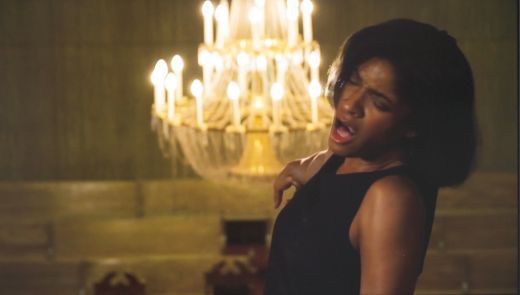- Americana (Pérez Art Museum Miami: December 4, 2013 – May 1, 2014)

- Barnacles on the Boat: Notions of Literature at the Key West Literary Seminar
Present Tense Future Perfect
Martha Raoli

Simone Leigh and Liz Magic laser in collaboration with Alicia Hall Moran, Breakdown, 2011. Digital video.
No medium is better fit to contemplate the gnawing redundancy of “what has been” than film. It is no wonder that the video component of this show dominates the space. “Breakdown” (2011) is a piece of absurdist theatrical monologue, whose inane circularity affirms and displaces our perceptions of time. It is the work of Simone Leigh and Liz Magic Laser, in collaboration with the opera singer Alicia Hall Moran, who portrays a statuesque hysteric in a black sheath dress—classy, coiffed and coming undone. Standing not on stage, but from the aisles of a grand, worn-down uptown theater, she implores to the camera, “Please strike that please don’t. Please don’t look. Erase.” It is impossible not to look at this high wire veering to the edge of a breakdown, and pulling back, vocalizing a struggle between decorum and disaster; hysteria and restraint via glitchy arias, grotesque convulsions, and then the clasping of hands, the deep breath. The salacious pleasure we derive from watching women spin out of control is currently being mined by TV networks, but the female breakdown has longtime roots in theatricality. Nineteenth-century doctors denounced women, ill with hysteria, as “veritable actresses”; their seizures were diagnosed as performance. In this context, Hall’s performance feels dangerous, marked by an uncanny bareness. With tantrums, weeping, and drunken scatting, she riffs on the caricatures of female madness, giving voice to the bizarre refrains of the script with the present-tense abandon of a jazz musician. Her off-the-rails performance invents a new opera.
Two inky black and white abstract photograms (2013) by Sheree Hovsepian, expose the alchemy of photography and the slight of hand. Silver gelatin sheets, each roughly 40” x 50”, through some miracle of light and chance, have acquired images, ghostly and smoke-like stains that feel alive, lucid, flowing. Aquatic or gaseous, they quiver like jellyfish or dark plumed smoke. These photograms are more Matisse than Man Ray, and point toward a painterly future of cameraless photography.
A six-foot birch wood crucifix, Duron Jackson’s “Bones Crusade,” (2012) looks like two intersecting open-faced coffins, lined with domino tiles which have been arranged randomly, irrespective of the game. Optically, dots vibrate like bits of digital data, an illusion of mobility that challenges their actual glued-down status. The impotent stasis of this unplayable game, perpetually immobile, advances the ambiguity of tenses.
The show also includes some devilish collages (2007) by Deborah Grant that remix Basquiat and pre-civil rights advertising imagery vis-a-vis Bill Traylor. Photographer Wyatt Gallery’s highly optimistic images of post-hurricane Haitian tent-towns (2010) in pastel and sunshine hues, assume the detached helicoptric distance of Vitalli’s umbrella-ed beaches. A counterfeit dollar by Sadie Barnette (2012) confirms its fakeness with a sharpie pen scribble. In the ambient soundtrack of “Breakdown,” the hermetic call and answer soliloquy: Why do I have to go to the ballgame? Because I have always done so. The future, as it were, may be a fait accompli.









